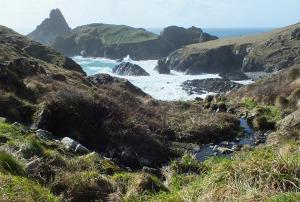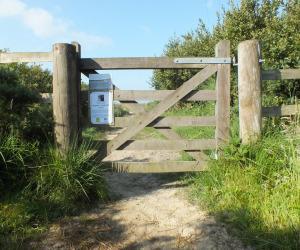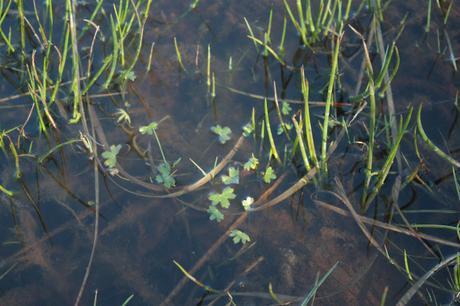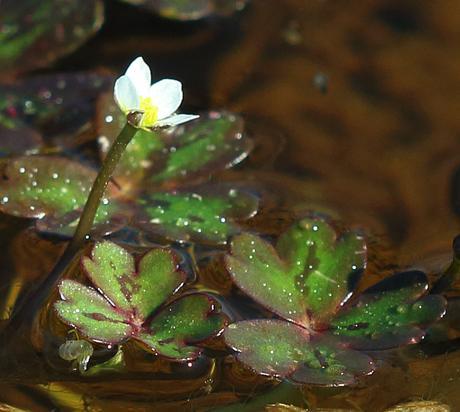The more traditional way to visit Kynance Cove on The Lizard is to park in the National Trust car park, walk down the footpath to the cove itself and enjoy the shimmering sea and serpentine followed by a cup of tea and slice of cake in the cafe. Then follows the steep but short slog back up the hill to the car.
 Kynance Cove
Kynance CoveIt will be spring or summer, and on a sunny day there will be many other people at this understandably popular spot. You might take a walk along the cliff top, either north towards Soapy Cove or south towards Caerthillian and Lizard Point. You will be rewarded by the wonderful flora of The Lizard all along the tops of the cliffs, from the Thrift that is everywhere to sweet-scented Chamomile to the rarer clovers that The Lizard is rightly renowned for.
The warmer months are, however, not my favorite time of year to make a trip to Kynance, and neither is this route the way I prefer to arrive there. I like to make the journey in winter, or early spring, starting from further east, taking a route across the Lizard Downs. The footpath is called by many the Grochall Track, though it does not call it that on the OS map, and it starts next to Kynance Garage petrol station at Mile End. It is not the most enticing of entryways, and on a dull winter day even less so.
 The gate through to the Lizard Downs National Nature Reserve
The gate through to the Lizard Downs National Nature ReserveBear with it, though. Two or three minutes along a hedge-bound path and you arrive at a gate announcing you have arrived at the Lizard Downs. Enter, and find a wonderful world. The track heads pretty much straight south-west. To the north lies a small-holding (marked Grochall on the OS map), now managed for conservation and owned by the National Trust since 2009. Walking westwards you find yourself on the National Nature Reserve, managed by the local Natural England team. In summer, when there has been enough sunshine, the track itself will be largely dry, its pale buff-coloured soil firm beneath your feet. There will be the beautiful Cornish Heath blooming in later summer, pink flowers of Common Centaury and, if you keep your eyes peeled, its tiny cousin Yellow Centaury, opening its petals to the warmth of the sun. Around you the Downs stretch out, coconut-scented gorse, heathers and grasses, in an expanse of green. Summer is a nice time to go, I admit.
It is a bit bleak, though, even in summer. Not many folk walk this way, away from the cliffs and coast. You cannot even see the sea until you get a mile or so further west. In winter, though, it takes on a bleakness at quite another level. A brisk, cool and bright day is great, but I much prefer it when it is vaguely misty and mizzly. The path is clear enough that it is impossible to get lost, but with your eyes cast downwards and your collar up, dim shapes hover at the edge of sight and the world contracts around you. The ubiquitous Purple Moor-grass takes on a whole new purpose: its knobbly clumps serve as stepping stones as you stomp and splash along what is now a path of sticky mud and puddles.
It is wonderful. Rather than lifting up your eyes to seek the horizon and the first sight of the sea, with Kynance the end goal, you are focussed on the ground, and so you notice things closer to your feet. Early frogspawn, for example, or the fine filaments of stoneworts in the puddles. And it will also be impossible to miss the winter treasure of my title: Three-lobed Crowfoot.
 Three-lobed Crowfoot, Lizard Downs
Three-lobed Crowfoot, Lizard DownsIt hardly looks like anything in the cold winter months, compared to some of the showier plants with which it shares the Downs. When I was studying at Tremough, I spent many weeks, in both winter and summer, surveying for Crowfoot on the west side of The Lizard, including the Grochall Track. Despite saying a few sentences ago that it is hard to miss, you do need to get your eye in. At first, I would stop at every puddle along the track looking for the plant hopefully: separating out its delicate small leaves from other vegetation could sometimes take several minutes. Eventually, though, the distinctive crowfoot shape imprinted itself firmly into my brain and I would find it quickly and with ease. As I closed my eyes at the end of a day surveying, lying pleasantly exhausted in bed, I would see crowfoot leaves floating before me.
“It grows into your soul like a favourite song”
I came to love it. I love the sight of a few of its leaves lying on the surface of a puddle as if they have been placed there, hidden in full sight for the weary traveler to find. I love it when you find a place where it has exploded, carpeting a shallow pool with exuberant abundance. I love the shape of it: the graceful smooth notches in the leaves creating the three-lobed form, the fairy-like gentle green color. An unpretentious little plant, it grows into your soul like a favorite song.
Then, in the earliest days of spring, it blossoms. Tiny, white, yellow-centred flowers held on stiff little stalks above the leaves. I remember the first time I saw its flowers, after weeks of searching for and counting the leaves. My amazement was out of all proportion to its diminutive petals. Maybe I was brain-fuddled by all the surveying, but I think it was rather that it was so precious to see this brave flower, holding out in the still cold depths of the downlands.
 Three-lobed Water Crowfoot in flower
Three-lobed Water Crowfoot in flowerThree-lobed Crowfoot is a national rarity. Its range has reduced considerably over the last few decades. It is still found in western Pembrokeshire, the New Forest, and on some sites in Devon and West Cornwall, but The Lizard remains one of its last strongholds. It is one of a few plants growing on the trackways that benefit from a low-level of disturbance, something that once would have been provided by the horse-drawn carts carrying serpentine from The Lizard’s quarries to the serpentine craft workshops (the Grochall track was one of these routes, before the toll road – now the main vehicular access to Kynance – was created in the 1930s). Disturbance reduces competition from other plants, so in order to conserve the Crowfoot, conservation managers now need to recreate similar levels of human activity, either by using grazing stock or by driving vehicles up and down the tracks – a fun thing to do, but with a serious point to it.
When I walk the Grochall Track in winter or early spring, arriving at Kynance is almost incidental. Sometimes I walk down the switchback path at the northern side of the cove, in order to feel the sand beneath my feet and admire the serpentine rocks. More often, though, I find a sheltered place to sit at the top of the cliffs and eat a sandwich, looking down on Kynance and Asparagus Island, at peace with the view and reflecting on the tranquillity of the Downs. Then I pick up my rucksack and head back along the Grochall Track, looking for more Crowfoot.

Getting to the Grochall track:
Travelling south through The Lizard down the A3083, at Mile End you will see Kynance Garage on your right (SW700145). Turn left immediately opposite and there is a small area on the left where you can park. Cross the A3083, taking care to avoid cars which shoot up and down the road here, and you will see the footpath starting to the left of the garage. The track (which is clearly marked on Ordnance survey maps) heads straight from here, bearing south-west until you reach the cliffs and sea and the road switchbacking down to the cove (SW685134). If you have left the car at Mile End, you will need to walk back the same way, unless you take the National Trust access (toll) road back to the A3083 and then walk north along the main road until you get back to Mile End. I would not recommend it, however – the A3083, although seldom chock-a-block full of traffic, is a straight and fast road. There is nothing to complain about in enjoying the Grochall Track twice – and it is safer.
Related walk:
I blogged before about a walk starting on the Grochall Track, but which then turns north before you get to Kynance and visits Lower Predannack and Kynance Gate prehistoric village. It was a summer walk, and I wouldn’t recommend it in winter (or summer) unless you have a good map and possibly even a compass if you are unfamiliar with The Lizard, as the paths away from the Grochall Track are not always as clear. In winter, if you think the Grochall Track is muddy, some of the other tracks leading away from it are spectacularly boggy. Sturdy walking boots are essential, and it is amazing how disorientating just a bit of mist can be.
Find out more:
Bates, Robin and Scolding, Bill, 2002. Wild Flowers of The Lizard. Cornwall Council, Truro (a great and accessible little book that will fit in your rucksack, written by two local experts, with good photos and available from most bookshops and gift shops in the area).
Find out more about Three-lobed Crowfoot on the Discovering the Natural Lizard website here, or on the Plantlife website here.
For anyone that wants to find out more about how low-level disturbance is of practical use in conserving Three-lobed Crowfoot and some of the other Lizard rarities, here is a link to the one scientific paper I have to my name, which explains the positive outcome of conservation work at nearby Windmill Farm. I may be the lead author (it came out of my university project study), but my co-authors are infinitely more knowledgeable: Scott A, Maclean IMD, Byfield A, Pay AR and Wilson RJ, 2012. Artificial disturbance promotes recovery of rare Mediterranean temporary pond plant species on the Lizard Peninsula, Cornwall, England. Conservation Evidence, 9, 79-86

